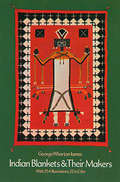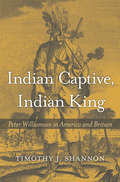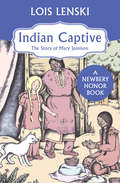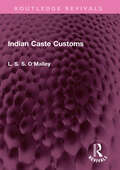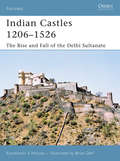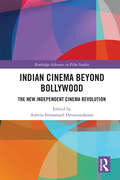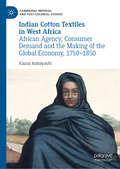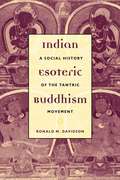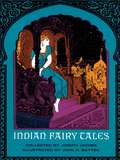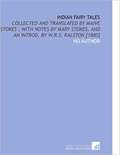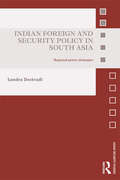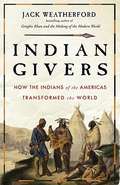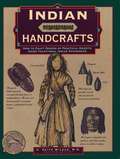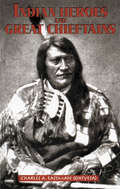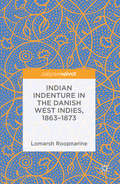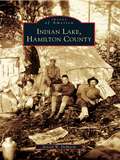- Table View
- List View
Indian Blankets and Their Makers
by George Wharton JamesHistory, old-style wool blankets, changes brought about by traders, symbolism of design and color, a Navajo weaver at work, more. Emphasis on Navajo. Includes information on the Bayeta blanket, squaw dresses, dyeing, belts, garters, hair braids, imitation blankets, the Chimayó blanket, and reliable dealers. 254 illustrations, 32 in color.
Indian Boyhood: The True Story of a Sioux Upbringing
by Charles Alexander EastmanImagine a childhood full of adventure. Where riding horses, playing in the woods, and hunting for food was part of everyday life; where a grizzly bear, a raccoon, or a squirrel was your favorite pet. But imagine, too, being an orphan at the age of six, being forced off your land by U.S. soldiers, and often going hungry. Such was the childhood of the first great American Indian author, Charles Eastman, or Ohiyesa (1858-1939).Carefully edited for a younger audience by multiple award-winning author and editor, Michael Oren Fitzgerald, Indian Boyhood recalls Eastman&’s earliest childhood memories. He was born in a buffalo hide tipi in western Minnesota, and raised in the traditional Dakota Sioux manner until he was fifteen years old. He was then transplanted into the &“white man&’s&” world. Educated at Dartmouth College, he went on to become a medical doctor, renowned author, field secretary for the YMCA, and a spokesman for American Indians. Eastman was at Pine Ridge during the &“Ghost Dance&” rebellion of 1890-91, and he cared for the wounded Indians after the massacre at Wounded Knee. In 1910 he began his long association with the Boy Scouts of America, helping Ernest Thompson Seton establish the organization. A 2007 HBO film, entitled Bury My Heart at Wounded Knee, features American Indian actor Adam Beach as Eastman.
Indian Buddhist Theories of Persons: Vasubandhu's Refutation of the Theory of a Self (Routledge Critical Studies in Buddhism)
by James DuerlingerIn this book, Vasubandhu's classic work Refutation of the Theory of a Self is translated and provided with an introduction and commentary. The translation, the first into a modern Western language from the Sanskrit text, is intended for use by those who wish to begin a careful philosophical study of Indian Buddhist theories of persons. Special features of the introduction and commentary are their extensive explanations of the arguments for the theories of persons of Vasubandhu and the Pudgalavâdines, the Buddhist philosophers whose theory is the central target of Vasubandhu's refutation of the theory of a self.
Indian Captive, Indian King: Peter Williamson in America and Britain
by Timothy J. ShannonIn 1758 Peter Williamson, dressed as an Indian, peddled a tale in Scotland about being kidnapped as a young boy, sold into slavery and servitude, captured by Indians, and made a prisoner of war. Separating fact from fiction, Timothy Shannon illuminates the curiosity about America among working-class people on the margins of empire.
Indian Captive: The Story of Mary Jemison
by Lois LenskiA Newbery Honor book inspired by the true story of a girl captured by a Shawnee war party in Colonial America and traded to a Seneca tribe. When twelve-year-old Mary Jemison and her family are captured by Shawnee raiders, she&’s sure they&’ll all be killed. Instead, Mary is separated from her siblings and traded to two Seneca sisters, who adopt her and make her one of their own. Mary misses her home, but the tribe is kind to her. She learns to plant crops, make clay pots, and sew moccasins, just as the other members do. Slowly, Mary realizes that the Indians are not the monsters she believed them to be. When Mary is given the chance to return to her world, will she want to leave the tribe that has become her family? This Newbery Honor book is based on the true story of Mary Jemison, the pioneer known as the &“White Woman of the Genesee.&” This ebook features an illustrated biography of Lois Lenski including rare images and never-before-seen documents from the author&’s estate.
Indian Caste Customs (Routledge Revivals)
by L. S. O'MalleyFirst published in 1932, Indian Caste Customs is an explication on how caste system operates in everyday life. What are its injunctions and prohibitions? What actions constitute offences against its moral law and social honour? What are the means by which breaches of that code are adjudicated? What are the penalties inflicted on offenders? The book attempts to answer these questions as well as discuss the merits and demerits of the caste system in India. This book will be of interest to students of history, sociology, anthropology and South Asian studies.
Indian Castles 1206-1526
by Brian Delf Konstantin NossovFrom the beginning of the 11th century onwards, the constant sate of war amongst the various Indian kingdoms left them open to outside attack, and Muslim Turkic tribesmen began to pour over the north-west border from modern-day Afghanistan. These raiders consolidated their successes and by 1206 a Muslim state, the Sultanate of Delhi, had been founded, which then extended its direct rule or influence over most of the subcontinent.A turbulent period followed. The Sultanate was in constant flux as five dynasties rose and fell: Mamluk or Slave (1206-90), Khalji (1290-1320), Tughluq (1320-1413), Sayyid (1414-51), and Lodi (1451-1526). 19 out of the 35 Sultans died at the hands of assassins and the Sultanate was torn by factional rivalries and court intrigues. As a consequence of this, the territory under its direct control expanded and shrank depending on the personality, fortunes and military success of each individual Sultan.This era is considered to be the defining age of Indian castle and fortification design. The instability and feudal division of the country throughout the greater part of the period led to the intense fortification of many of the provinces, as each small lord sought to bolster his position by constructing castles. It was also the period during which Indian castles started to show their defining features, elements of which would be modified in later years as the technology of siege warfare evolved. The combined influence of the Islamic and Hindu architectural tradition lends these fortifications a unique and exotic style. This book covers all the major sites of the period, including the fabled seven medieval cities on the site of present-day Delhi, as well as the most prominent sieges.
Indian Cinema Beyond Bollywood: The New Independent Cinema Revolution (Routledge Advances in Film Studies)
by Ashvin Immanuel DevasundaramThis is the first edited volume on new independent Indian cinema. It aims to be a comprehensive compendium of diverse theoretical, philosophical, epistemological and practice-based perspectives, featuring contributions from multidisciplinary scholars and practitioners across the world. This edited collection features analyses of cutting-edge new independent films and is conceived to serve as a beacon to guide future explorations into the burgeoning field of new Indian Cinema studies.
Indian Constitution: Design and Practice
by Bidyut ChakrabartyThe book deals with the making and unfolding of the Constitution of India, framed by the Constituent Assembly between 1946 and 1949. Superseding the conventional legalistic approach, it focuses on the politico-ideological priorities of the members of Assembly who played a critical role in preparing the provisions of the Constitution.With its appeal cutting across academic specializations, this book stands out as a significant document by making readers aware of their constitutional rights and duties and the ways to utilize the constitutional directions for human and national betterment. Written in lucid language, this book is a great asset for those seeking to understand the complex ideas implicit in legally articulated provisions.Tailored to the academic requirements of a global readership, this volume would be useful to students, researchers and teachers working in the fields of Politics, Law, public administration and public policy. It would also be an invaluable resource for legal experts and policymakers.
Indian Cotton Textiles in West Africa: African Agency, Consumer Demand and the Making of the Global Economy, 1750–1850 (Cambridge Imperial and Post-Colonial Studies Series)
by Kazuo KobayashiThis book focuses on the significant role of West African consumers in the development of the global economy. It explores their demand for Indian cotton textiles and how their consumption shaped patterns of global trade, influencing economies and businesses from Western Europe to South Asia. In turn, the book examines how cotton textile production in southern India responded to this demand. Through this perspective of a south-south economic history, the study foregrounds African agency and considers the lasting impact on production and exports in South Asia. It also considers how European commercial and imperial expansion provided a complex web of networks, linking West African consumers and Indian weavers. Crucially, it demonstrates the emergence of the modern global economy.
Indian Crisis: The Background (Routledge Revivals)
by John S. HoylandThe author of Indian Crisis (first published in 1943) spent over fifteen years as an educationalist and social and religious worker in India and was awarded the Kaiser-i-Hind Gold Medal for Public Service. He has had prolonged personal acquaintance not only with the Indian “intellectuals”, but also with the concrete problems of poverty, famine, and epidemic as they are met with not only in the Indian industrial city and the small country town, but also in the villages in agricultural districts and amongst the jungle tribes. He is convinced that the present British system must give way as swiftly as possible to a future in which India shall have liberty to devise and run her own system of government. The difficulties ahead, especially in regard to the multitudinous divisions of caste, creed, and community, are squarely faced; the tragic failures and mistakes of the recent war years are dealt with; and full consideration is given to the permanent influence of great movements of thought, which coming from the distant past mould both personalities and movements in modern India. This book will be beneficial for anyone interested in the colonial history of India.
Indian Esoteric Buddhism: A Social History of the Tantric Movement
by Ronald DavidsonThis groundbreaking work describes the historical origins of the Tantric movement in early medieval India. Drawing on primary documents--translated into English for the first time from Sanskrit, Prakrit, and Bengali--Davidson shows how changes in medieval Indian society, including economic and patronage crises, a decline in women's participation, and the formation of large monastic orders, led to the rise of the esoteric tradition in India that became the model for Buddhist cultures in China, Tibet, and Japan.
Indian Esoteric Buddhism: A Social History of the Tantric Movement
by Ronald DavidsonDespite the rapid spread of Buddhism—especially the esoteric system of Tantra, one of its most popular yet most misunderstood forms—the historical origins of Buddhist thought and practice remain obscure. This groundbreaking work describes the genesis of the Tantric movement in early medieval India, where it developed as a response to, and in some ways an example of, the feudalization of Indian society. Drawing on primary documents—many translated for the first time—from Sanskrit, Prakrit, Tibetan, Bengali, and Chinese, Ronald Davidson shows how changes in medieval Indian society, including economic and patronage crises, a decline in women's participation, and the formation of large monastic orders, led to the rise of the esoteric tradition in India that became the model for Buddhist cultures in China, Tibet, and Japan.
Indian Fairy Tales
by Joseph JacobsSoils and national characteristics differ, but fairy tales are the same in plot and incidents the world over. So proved the leading British folklorist Joseph Jacobs (1854-1916) with this now classic volume of 29 traditional tales from India, including some of the oldest recorded tales known."The Lion and the Crane," "How the Raja's Son Won the Princess Labam," "The Broken Pot," "The Tiger, the Brahman, and the Jackal," "The Talkative Tortoise," "The Ass in the Lion's Skin," "Why the Fish Laughed," "Sun, Moon, and Wind Go Out to Dinner," "The Prince and the Fakir," and all the other stories make delightful reading or listening for youngsters who are tired of the same familiar old favorites. John D. Batten's nine full-page plates and his 37 other drawings are reproduced from the original edition.
Indian Fairy Tales: 1880
by W. R. S. Ralston Maive Stokes Mary StokesOriginally published in 1880. This volume from the Cornell University Library's print collections was scanned on an APT BookScan and converted to JPG 2000 format by Kirtas Technologies. All titles scanned cover to cover and pages may include marks notations and other marginalia present in the original volume.
Indian Folk Theatres
by Julia HollanderIndian Folk Theatres is theatre anthropology as a lived experience, containing detailed accounts of recent folk theatre shows as well as historical and cultural context. It looks at folk theatre forms from three corners of the Indian subcontinent: Tamasha, song and dance entertainments from Maharastra Chhau, the lyrical dance theatre of Bihar Theru Koothu, satirical, ritualised epics from Tamil Nadu. The contrasting styles and contents are depicted with a strongly practical bias, harnessing expertise from practitioners, anthropologists and theatre scholars in India. Indian Folk Theatres makes these exceptionally versatile and up-beat theatre forms accessible to students and practitioners everywhere.
Indian Foreign and Security Policy in South Asia: Regional Power Strategies (Asian Security Studies)
by Sandra DestradiThis book examines Indian foreign policy and security relations in its eastern regional neighbourhood. Indian Foreign and Security Policy in South Asia conducts an in-depth analysis into India’s foreign policy towards the three main countries in India’s Eastern neighbourhood – Sri Lanka, Nepal, and Bangladesh. In particular, it deals with India’s role in the final years of the civil war in Sri Lanka, its approach to the peace and democratisation process in Nepal, and Indian foreign policy towards Bangladesh on a range of issues including Islamist militancy, migration, border security, and insurgency. Set within an analytical framework centred on the notions of ‘empire’, ‘hegemony’, and ‘leadership’, the study reveals that India pursued predominantly hegemonic strategies and was not able to generate genuine followership among its smaller neighbours. The South Asian case therefore shows the discrepancy that may exist between the possession of power capabilities and the ability to exercise actual influence: a conclusion which lifts the study from geographical specifics, and extends its relevance to other cases and cross-regional comparisons. This text will be of much interest to students of Indian foreign policy, Asian security, foreign policy analysis, strategic studies and IR in general.
Indian Geography For IAS Prelims Competetive Exam
by Indic TrustThis is a compilation of questions answer of Indian Geography for Prelims Exam.
Indian Givers: How Native Americans Transformed the World
by Jack Weatherford"As entertaining as it is thoughtful....Few contemporary writers have Weatherford's talent for making the deep sweep of history seem vital and immediate."THE WASHINGTON POSTAfter 500 years, the world's huge debt to the wisdom of the Indians of the Americas has finally been explored in all its vivid drama by anthropologist Jack Weatherford. He traces the crucial contributions made by the Indians to our federal system of government, our democratic institutions, modern medicine, agriculture, architecture, and ecology, and in this astonishing, ground-breaking book takes a giant step toward recovering a true American history.From the Trade Paperback edition.
Indian Givers: How the Indians of the Americas Transformed the World
by Jack Weatherford"As entertaining as it is thoughtful. . . . Few contemporary writers have Weatherford's talent for making the deep sweep of history seem vital and immediate. " THE WASHINGTON POST After 500 years, the world's huge debt to the wisdom of the Indians of the Americas has finally been explored in all its vivid drama by anthropologist Jack Weatherford. He traces the crucial contributions made by the Indians to our federal system of government, our democratic institutions, modern medicine, agriculture, architecture, and ecology, and in this astonishing, ground-breaking book takes a giant step toward recovering a true American history.
Indian Handcrafts: How To Craft Dozens Of Practical Objects Using Traditional Indian Techniques (Illustrated Living History Series)
by C. Keith WilburIndian Handcrafts explains how each object evolved, how it was used, and what tools and materials you need to re-create it.
Indian Heroes and Great Chieftains (Native American)
by Charles A. EastmanRaised as a young Sioux in the 1860s and 1870s, Eastman knew some of the Indian leaders he portrays here in vivid, biographical sketches. Included are Red Cloud, Rain-in-the-Face, Crazy Horse, Sitting Bull, Little Crow, Chief Joseph and 9 more. These inspiring pieces are enhanced with 12 portraits.
Indian Indenture in the Danish West Indies, 1863-1873
by Lomarsh RoopnarineThis book is the first comprehensive analysis of Denmark's solitary experiment with Indian indentured labor on St. Croix during the second half of the nineteenth century. The book focuses on the recruitment, transportation, plantation labor, re-indenture, repatriation, remittances and abolition of Indian indentured experience on the island. In doing so, Roopnarine has produced a compelling narrative on Indian indenture. The laborers challenged and responded accordingly to their daily indentured existence using their cultural strengths to cohere and co-exist in a planter-dominated environment. Laborers had to create opportunities for themselves using their homeland customs without losing the focus that someday they would return home. Indentured Indians understood that the plantation system would not be flexible to them but rather they had to be flexible to plantation system. Roopnarine's concise analysis has moved Indian indenture from the margin to mainstream not only in the historiography of the Danish West Indies, but also in the wider Caribbean where Indians were indentured.
Indian Knowledge System First Semester FYBA New NEP Syllabus - SPPU
by Dr Neeta Suresh Mohite Dr Dnyandev Laxman Nitve Dr Rupali Bipin Sheth Dr Manisha Deepak PuranikThe book "Indian Knowledge System" introduces students to India's ancient and diverse knowledge traditions as part of the National Education Policy (NEP) 2020 curriculum. It covers the evolution of scientific thought, contributions of scholars like Aryabhata and Varahamihira in astronomy, Ayurveda and Unani medicine, and advancements in metallurgy. The text also explores India's rich humanities, including languages like Sanskrit and Prakrit, various philosophical traditions, ancient education systems such as Takshashila and Nalanda, and architectural heritage, particularly temple architecture. The book aims to preserve, research, and integrate this traditional knowledge into modern education, emphasizing its scientific and cultural significance for contemporary learners.
Indian Lake, Hamilton County (Images of America)
by Arnold W. DemarshThe village of Indian Lake was formally founded in 1858, during a time when many small communities were springing up in the Adirondacks as a result of the lumber industry. In 1889, Dr. Thomas C. Durant established a branch of the Delaware and Hudson Railroad that connected Saratoga Springs and North Creek. Through the later part of the 19th century and early-20th century, the Adirondack Mountains became a paradise destination for the rich and famous. Indian Lake, which began as a stopover for Blue Mountain Lake and Raquette Lake, quickly grew into a tourist center in its own right because of its ideal location and beauty. Indian Lake, Hamilton County is a pictorial journey through the golden age of this region, a haven of beauty and nature.
